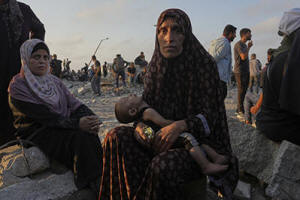Israel's leader claims no one in Gaza is starving. Data and witnesses
disagree
[July 29, 2025]
By CARA ANNA
Israeli Prime Minister Benjamin Netanyahu says no one in Gaza is
starving: “There is no policy of starvation in Gaza, and there is no
starvation in Gaza. We enable humanitarian aid throughout the duration
of the war to enter Gaza – otherwise, there would be no Gazans.”
President Donald Trump on Monday said he disagrees with Netanyahu’s
claim of no starvation in Gaza, noting the images emerging of emaciated
people: “Those children look very hungry.”
After international pressure, Israel over the weekend announced
humanitarian pauses, airdrops and other measures meant to allow more aid
to Palestinians in Gaza. But people there say little or nothing has
changed on the ground. The U.N. has described it as a one-week scale-up
of aid, and Israel has not said how long these latest measures would
last.
"This aid, delivered in this way, is an insult to the Palestinian
people,” said Hasan Al-Zalaan, who was at the site of an airdrop as some
fought over the supplies and crushed cans of chickpeas littered the
ground.
Israel asserts that Hamas is the reason aid isn’t reaching Palestinians
in Gaza and accuses its militants of siphoning off aid to support its
rule in the territory. The U.N. denies that looting of aid is systematic
and that it lessens or ends entirely when enough aid is allowed to enter
Gaza.
Here's what we know:
Deaths are increasing
The World Health Organization said Sunday there have been 63
malnutrition-related deaths in Gaza this month, including 24 children
under the age of 5 — up from 11 deaths total the previous six months of
the year.

Gaza's Health Ministry puts the number even higher, reporting 82 deaths
this month of malnutrition-related causes: 24 children and 58 adults. It
said Monday that 14 deaths were reported in the past 24 hours. The
ministry, which operates under the Hamas government, is headed by
medical professionals and is seen by the U.N. as the most reliable
source of data on casualties. U.N. agencies also often confirm numbers
through other partners on the ground.
The Patient’s Friends Hospital, the main emergency center for
malnourished kids in northern Gaza, says this month it saw for the first
time malnutrition deaths in children who had no preexisting conditions.
Some adults who died suffered from such illnesses as diabetes or had
heart or kidney ailments made worse by starvation, according to Gaza
medical officials.
The WHO also says acute malnutrition in northern Gaza tripled this
month, reaching nearly one in five children under 5 years old, and has
doubled in central and southern Gaza. The U.N. says Gaza's only four
specialized treatment centers for malnutrition are “overwhelmed.”
The leading international authority on food crises, the Integrated Food
Security Phase Classification, has warned of famine for months in Gaza
but has not formally declared one, citing the lack of data as Israel
restricts access to the territory.

[to top of second column]
|

Somoud Wahdan looks at the camera as she sits with her child in an
area in the northern Gaza Strip, while waiting for trucks with
humanitarian aid to arrive, in Gaza City, Friday, July 25, 2025. (AP
Photo/Abdel Kareem Hana)

Aid trucks are swarmed by hungry people
The measures announced by Israel late Saturday include 10-hour daily
humanitarian pauses in fighting in three heavily populated areas, so
that U.N. trucks can more more easily distribute food.
Still, U.N. World Food Program spokesperson Martin Penner said the
agency's 55 trucks of aid that entered Gaza on Monday via the
crossings of Zikim and Kerem Shalom were looted by starving people
before they reached WFP warehouses.
Experts say that airdrops, another measure Israel announced, are
insufficient for the immense need in Gaza and dangerous to people on
the ground. Israel’s military says 48 food packages were dropped
Sunday and Monday.
Palestinians say they want a full return to the U.N.-led aid
distribution system that was in place throughout the war, rather
than the Israeli-backed mechanism that began in May. Witnesses and
health workers say Israeli forces have killed hundreds by opening
fire on Palestinians trying to reach those food distribution hubs or
while crowding around entering aid trucks. Israel’s military says it
has fired warning shots to disperse threats.
The U.N. and partners say that the best way to bring food into Gaza
is by truck, and they have called repeatedly for Israel to loosen
restrictions on their entry. A truck carries roughly 19 tons of
supplies.
Israel’s military says that as of July 21, 95,435 trucks of aid have
entered Gaza since the war began. That’s an average of 146 trucks
per day, and far below the 500 to 600 trucks per day that the U.N.
says are needed.
The rate has sometimes been as low as half of that for several
months at a time. Nothing went in for 2 1/2 months starting in March
because Israel imposed a complete blockade on food, fuel and other
supplies entering Gaza.

Delivering aid is difficult and slow
The U.N. says that delivering the aid that is allowed into Gaza has
become increasingly difficult.
When aid enters, it is left just inside the border in Gaza, and the
U.N. must get Israeli military permission to send trucks to pick it
up. But the U.N. says the military has denied or impeded just over
half the movement requests for its trucks in the past three months.
If the U.N. succeeds in picking up the aid, hungry crowds and armed
gangs swarm the convoys and strip them of supplies. The Hamas-run
civilian police once provided security along some routes, but that
stopped after Israel targeted them with airstrikes.
All contents © copyright 2025 Associated Press. All rights reserved |